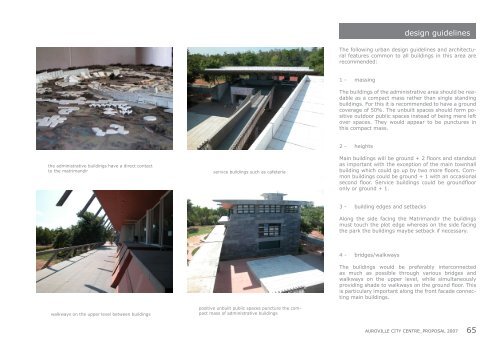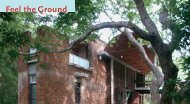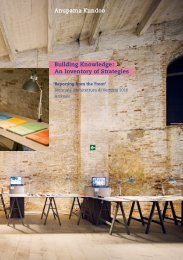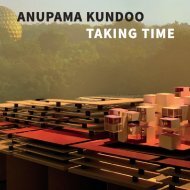Proposal for Auroville City Center. Anupama Kundoo architects. 2007
This proposal for Auroville City Center, was produced in 2007 by Anupama Kundoo and her team under the supervision of Roger Anger. It is based upon the Chief Architect's city plan for Auroville as envisioned by Mirra Alfassa, aka the Mother, with which Auroville was founded on 28 February 1968 in Tamil Nadu, India. This document was produced in order to initiate the development of the City Center with a population of 5000 inhabitants and take the first urban step towards realising Auroville. It serves as the basis to invite technical inputs and strategies for mobility, energy, water and other infrastructure in the direction of Auroville's defined vision and aims. The next phase would integrate technical inputs and propose the detail development plans. Documents referred to: Auroville Masterplan. Project proposal by Roger Anger, 1968 Auroville Universal Township Masterplan: Perspective 2025, Jointly prepared by Auroville Foundation and Town and Country Planning Organisation, Government of India, Ministry of Urban Development and Poverty Alleviation, 2001(approved by HRD Ministry on 12.04.2001) Guidelines for Integrated Urban and Rural Lanscaping in Auroville, Helge Jung, May 2001 Auroville Mobility Concept, Planungsbüro Billinger, August 2001 Auroville Universal Township Masterplan 2004: Directions for Growth Project proposal part of “Auroville Innovative Urban Management” project No. IND-015 of the AsiaUrbs project of the European Commission, 2003 Prefeasibility study on Water Supply, Storm Water Management for the City of Auroville. Study by Harald Kraft, Feb 2003 C.I.R.H.U. Auroville’s Future, 2003 Auroville City Center Proposal by Anupama Kundoo, February 2004 Auroville City Center Proposal by Auroville’s Future, 2005 Auroville Mobility, Auroville’s Future, February 2005 Administrative Area, Auroville. Project proposal by Anupama Kundoo, 01.02.2006 Auroville Townhall. Project proposal by Anupama Kundoo, 15.02.2007 sources
This proposal for Auroville City Center, was produced in 2007 by Anupama Kundoo and her team under the supervision of Roger Anger. It is based upon the Chief Architect's city plan for Auroville as envisioned by Mirra Alfassa, aka the Mother, with which Auroville was founded on 28 February 1968 in Tamil Nadu, India. This document was produced in order to initiate the development of the City Center with a population of 5000 inhabitants and take the first urban step towards realising Auroville. It serves as the basis to invite technical inputs and strategies for mobility, energy, water and other infrastructure in the direction of Auroville's defined vision and aims. The next phase would integrate technical inputs and propose the detail development plans.
Documents referred to:
Auroville Masterplan. Project proposal by Roger Anger, 1968
Auroville Universal Township Masterplan: Perspective 2025, Jointly prepared by Auroville Foundation and Town and Country Planning Organisation, Government of India, Ministry of Urban Development and Poverty Alleviation, 2001(approved by HRD Ministry on 12.04.2001)
Guidelines for Integrated Urban and Rural Lanscaping in Auroville, Helge Jung, May 2001
Auroville Mobility Concept, Planungsbüro Billinger, August 2001
Auroville Universal Township Masterplan 2004: Directions for Growth
Project proposal part of “Auroville Innovative Urban Management” project No. IND-015 of the AsiaUrbs project of the European Commission, 2003
Prefeasibility study on Water Supply, Storm Water Management for the City of Auroville. Study by Harald Kraft, Feb 2003
C.I.R.H.U. Auroville’s Future, 2003
Auroville City Center Proposal by Anupama Kundoo, February 2004
Auroville City Center Proposal by Auroville’s Future, 2005
Auroville Mobility, Auroville’s Future, February 2005
Administrative Area, Auroville. Project proposal by Anupama Kundoo, 01.02.2006
Auroville Townhall. Project proposal by Anupama Kundoo, 15.02.2007
sources
Create successful ePaper yourself
Turn your PDF publications into a flip-book with our unique Google optimized e-Paper software.
design guidelines<br />
The following urban design guidelines and architectural<br />
features common to all buildings in this area are<br />
recommended:<br />
1 - massing<br />
The buildings of the administrative area should be readable<br />
as a compact mass rather than single standing<br />
buildings. For this it is recommended to have a ground<br />
coverage of 50. The unbuilt spaces should <strong>for</strong>m positive<br />
outdoor public spaces instead of being mere left<br />
over spaces. They would appear to be punctures in<br />
this compact mass.<br />
the administrative buildings have a direct contact<br />
to the matrimandir<br />
service buildings such as cafeteria<br />
2 - heights<br />
Main buildings will be ground + 2 floors and standout<br />
as important with the exception of the main townhall<br />
building which could go up by two more floors. Common<br />
buildings could be ground + 1 with an occasional<br />
second floor. Service buildings could be groundfloor<br />
only or ground + 1.<br />
3 - building edges and setbacks<br />
Along the side facing the Matrimandir the buildings<br />
must touch the plot edge whereas on the side facing<br />
the park the buildings maybe setback if necessary.<br />
walkways on the upper level between buildings<br />
positive unbuilt public spaces puncture the compact<br />
mass of administrative buildings<br />
4 - bridges/walkways<br />
The buildings would be preferably interconnected<br />
as much as possible through various bridges and<br />
walkways on the upper level, while simultaneously<br />
providing shade to walkways on the ground floor. This<br />
is particulary important along the front facade connecting<br />
main buildings.<br />
AUROVILLE CITY CENTRE_PROPOSAL <strong>2007</strong> 65








